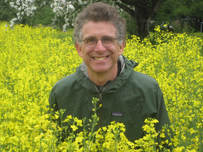 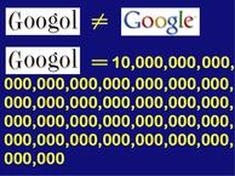 Can you put into words what these equations are telling you? Can you put into words what these equations are telling you? Think of a big number. How about one million? It's a thousand thousand. That's a lot. If you counted nonstop to a million, it would take you about 23 days. A million is small compared to a billion, which is a thousand million. Want to count that high? You'll be at it for 95 years. But a trillion makes a billion look puny. A trillion is a thousand billion (or a million million). Counting that high would take you 200,000 years. Have fun! Of course trillion is not the biggest number. There's quadrillion, quintillion, sextillion, septillion, octillion, nonillion, decillion and more. Each is a thousand of the previous one. There's even a humongous number called vigintillion, a one with 63 zeros. But vigintillion is a shrimp compared to a googol. Googol? Notice how it's spelled: G-O-O-G-O-L, not G-O-O-G-L-E. The number googol is a one with a hundred zeros. It got its name from a nine-year old boy. A googol is more than all the hairs in the world. It's more than all the grass blades and all the grains of sand. It's even more than the number of atoms in the universe. Astrophysicists estimate the number of atoms to be a one with 82 zeros. You'd need to add 18 more zeros to get to a googol. Incidentally, a few years ago, the two men who had invented a powerful new internet search engine decided to name their website and company for the gigantic number googol. But they spelled it wrong. That's why the company Google is spelled with an L-E. But the number googol is still spelled with an O-L. Googol is so large that it's practically useless, but the boy who named it came up with a name for an even bigger number, "googolplex." A googolplex is a one with a googol zeros. There isn't enough ink in all the pens of the world to write that many zeros but feel free to give it a try. So is googolplex is the biggest number? What about a googolplex and one? Two googolplex? A googolplex googolplex? Any number you say, I can say one bigger. I hear you asking, "What about infinity? Isn't that the biggest number?" Sorry, but infinity isn't a number. A number specifies an amount and infinity is no amount. It means "goes on and on forever." And that's what numbers do. They go on and on forever. Infinity is not a number but numbers are infinite. 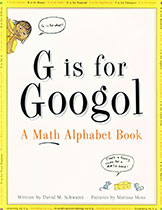 Think you're too old for an alphabet book? You'll think again if you check out a sampling from David M. Schwartz's: B is for Binary, F is for Fibonacci, P is for Probability... You can see that this is an ABC book unlike any other. For more information, click here. David Schwartz is a member of iNK's Authors on Call and is available for classroom programs through FieldTripZoom, a terrific technology that requires only a computer, wifi, and a webcam. Click here to find out more MLA 8 Citation
Schwartz, David M. "What's the Biggest Number?" Nonfiction Minute, iNK Think Tank, 1 Dec. 2017, www.nonfictionminute.org/ Whats-the-Biggest-Number.
290 Comments
When you think of the Olympics you think of the sports: Speed skating, Bobsled. Snowboarding. Track, Gymnastics. Swimming. Tennis. Just to name a few. You may even think about some of the Olympians: Snowboarders Shaun White and Kelly Clark. Speed skater Apollo Ohno. Swimmers Michael Phelps and Katie Ledecky. Or even gymnast Simone Biles and sprinter Usain Bolt. But do you ever think about the science behind each sport? You should. Math and physics play a huge part in every part in the Olympics. Think about it. One of the most basic forces, friction, is a factor in everything an athlete does. What is friction? It’s the force that pushes back on you as you swim through the water or run through the air. Friction not only affects an athlete, but also the object they may be throwing, hitting, or kicking—like a baseball, a tennis ball, or a soccer ball. Movement of any kind deals with physics of air flow, engineering design, and (unfortunately) sometimes collision. The verdict? Athletes need to know a LOT of science to do well in their sports. Science is not just found in the activities themselves but also in the equipment they use and clothes they wear. Most of today’s superstar athletes rely on clothing and equipment enhanced with nanotechnology. What is nanotechnology? Nanotechnology is the science of the super small—microscopic even. One nanowire is 1,000 time thinner than a single strand of human hair. Now that is SMALL! Materials made with nanotechnology are stronger, more durable, and yet lighter and more flexible. Nanotechnology produces swimsuits that allow the athlete to glide through the water faster, golf clubs that hit the ball farther, and tennis rackets that flex more easily to provide the hard smash across the net. This innovative new technology has already been used in the Olympics. In 2008, swimmers Michael Phelps and Natalie Coughlin wore swimsuits that were created with nanofibers. These nanofibers are woven tightly so that the swimmer’s bodies become more streamlined (like a shark!) allowing them to glide through the water faster. In the 2014 winter Olympics, the U.S. speed skaters wore specially created vented suits (like the swimsuits—to reduce drag), and in the 2018 winter Olympics, the USA Snowboarders will be wearing snow gear inspired by the space program. Nanotechnology is a cutting-edge science that is changing the world of sports—and in particular the Olympics— as we know it. Will you make nanotechnology part of your game? The LZR Racer is a line of completion swimsuits manufactured by Speedo using a high-technology swimwear fabric. In March 2008, athletes wearing the LZR Racer broke 13 swimming world records. Much like other suits used for high competition racing, LZR Racers allow for better oxygen flow to the muscles, and hold the body in a more hydrodynamic position, while repelling water and increasing flexibility. Kathy Barnstorff via Wikimedia Commons Serena Williams uses a nanotech racket and Phil Mickelson uses nanotech technology in his game. Seems to be going well for both of them. (l) Wikimedia Commons (R) Photo by Siyi Chen via Wikimedia Commons  A graphic highlighting all of the ways nanotechnology enhances the effectiveness of sports equipment. Nanowerk via Wikimedia 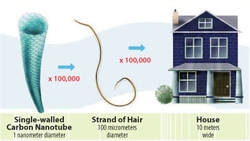 You would have to increase a carbon nanotube x100,000 to make it the size of a strand of hair. NIEH.gov  Want to know more? Jennifer Swanson's Super Gear: Nanotechnology and Sports Team Up was listed as one of the 2016 Best STEM Books by the National Science Teachers Association. Colorfully illustrated by photos, this book introduces "the science of the very small" as applied to sports equipment and clothing. MLA 8 Citation
Swanson, Jennifer. "The Science Behind the Olympics." Nonfiction Minute, iNK Think Tank, 7 Feb. 2018, www.nonfictionminute.org/the-nonfiction-minute/ the-science-behind-the-olympics. 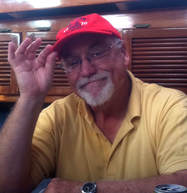 Most disasters are a cascade: small failures and minor circumstances, one leading to another, blossom into a cataclysm. On January 16, 1919, a cascade of tremendous size was poised above Boston’s North End. The weather was one factor: unusually warm for winter. Purity Distilling Company fermented and distilled molasses to make rum and alcohol. The 18th Amendment to the United States Constitution, prohibiting sales of alcoholic beverages, was due to be passed the very next day. This may have prompted Purity to collect as much molasses as possible. The enormous tank holding the molasses was about 50 feet tall and 90 feet in diameter, holding 2,300,000 gallons. It was poorly built of thin steel painted brown to hide its leaks. Local families often collected some of the dripping molasses to sweeten their food. The unseasonably warm temperature quickly rose from 2° F (-16.7° C) to 40° F (4.4° C), expanding the liquid, and natural fermentation produced CO2 increasing tank pressure. Just after noon, North End families felt the ground shake and heard a sound like a machine gun— the tank’s rivets popping out. The big tank exploded, sending a 25-foot wall of molasses roaring down the hill toward Commercial Street at about 35 miles an hour. In front of the molasses went a blast of air that blew some folks off their porches and tumbled others along the street like rag dolls. Homes and buildings were destroyed, smashed from their foundations. Horses pulling wagons were swept away. The steel girders of the Boston Elevated Railway were buckled, knocking a rail-car off the tracks. Twenty-one people were killed and more than a hundred were injured. Many were saved by Massachusetts Maritime Academy cadets who rushed off their docked training vessel and plunged into the brown goo to rescue people. It’s difficult to know how many dogs, cats and horses died. As you can imagine, the clean-up was awful. Firehoses from hydrants and harbor fireboats washed away as much as possible. Boston Harbor was brown for months. Sightseers tracked the goo back to homes, into hotels, onto pay-phones and onto doorknobs. Everything Bostonians touched was sticky for months. Some say that on a hot summer day along the North End’s docks, the sickly sweet smell of molasses lingers. Bostonians can smile at the Great Molasses Flood now, but in January of 1919, that cascade of disasters was deadly serious. Jan Adkins is an author, an illustrator, and a superb storyteller. Read about him on his Amazon page. He is also a member of iNK's Authors on Call and is available for classroom programs through Field Trip Zoom, a terrific technology that requires only a computer, wifi, and a webcam. Click here to find out more. MLA 8 Citation
Adkins, Jan. "The Great Boston Molasses Flood: How Can a Tragedy Sound Funny?" Nonfiction Minute, iNK Think Tank, 19 Jan. 2018, www.nonfictionminute.org/the-nonfiction-minute/ The-Great-Boston-Molasses-Flood-How-Can-a-Tragedy-Sound-Funny? 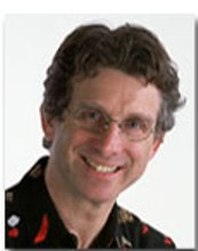  Do you want to be a lot older? Here’s how: state your age in seconds instead of years! Ready to do some math? But what math will you do? First you have to design a problem-solving strategy. There are many approaches but for all of them, consider that with every passing second, you are a second older. So your age is a moving target. Best to pick a specific time of day and find your age in seconds at that time today. It doesn’t really matter what time of day you pick. If you can find out from your birth certificate what time of day you were born, you could select that time today for your target. If you were born at 4:14pm, you will find out how old you are (in seconds) at 4:14pm today. Or just pick any time today and pretend you were born at that time. What next? I hope you will try out your own approach but here is a simple strategy that would work: Step 1. How many days old are you? Figure out how many days elapsed between the day you were born and your most recent birthday. There are 365 days in a year, not counting leap years. In your lifetime, every year divisible by 4 was a leap year and it had a 366th day, which was February 29th. So add an extra day for each February 29th you’ve lived through. Then figure out how many days have passed since your last birthday. Try to find a way to make this job quicker than counting each day. Look at calendars as you do this to find shortcuts. Now you have your age in days. It’s already looking like a big number, isn’t it? Just wait! Step 2. How many seconds are in a day? Think about how to figure this out. You know how many seconds are in a minute (60) and how many minutes are in an hour (60) and how many hours are in a day (24). So how many seconds are in a day? Multiply 60 X 60 X 24. Bet you didn’t realize a day was so long! Step 3 So what’s Step 3? You now know how many days you have lived and how many seconds are in a day, so what do you do next? Again, multiply! Next time someone tells you you’re not old enough to do something, you can tell him or her, “Oh yes I am. I’m 299,592,620. That’s what I was at 11:30 this morning. Now I’m even older!” Good luck with that! 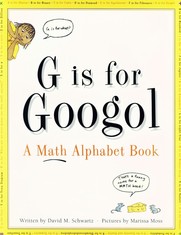 A is for “abacus,” B is for “binary,” C is for “cubit” and W is for “When are we ever gonna use this stuff, anyway?” David M. Schwartz's G is for Googol: A Math Alphabet Book is a wonder-filled romp through the world of mathematics. For more information, click here. David is a member of iNK's Authors on Call and is available for classroom programs through Field Trip Zoom, a terrific technology that requires only a computer, wifi, and a webcam. Click here to find out more. Schwartz, David. "How Old Are You...in Seconds?" Nonfiction Minute, iNK Think
Tank, 3 May 2018, www.nonfictionminute.org/the-nonfiction-minute/ How-Old-Are-You-in-Seconds.
In spring 1665 a college student named Isaac Newton studied natural philosophy, what we call “science.” Back then, a good student could learn everything to know about the natural world. But plague, the Black Death, came to England. Cambridge University closed. Isaac went home to Woolsthorpe. For two years Isaac thought about his studies during four years at university. He’d always been thoughtful—not the best at games, making friends, or minding sheep. But everybody knew Isaac Newton liked to think. Folks told time by the sundial he’d drawn on a wall. Home at Woolsthorpe, Isaac’s learning about science and math bubbled up in his head like yeast rising in a loaf of bread. So... Newton unplugged. His mind roamed like that of an artist or composer. He was driven by the need to create—not paintings or symphonies, but questions. “Why do things always fall down?” “Why does the earth move around the sun? “Why doesn’t the moon fall onto the earth?” “Does everything ‘up there” work like things work ‘down here?’” Isaac Newton answered his questions with three science rules, Newton’s Laws of Motion. At Woolsthorpe, Newton grappled with the concept of moving objects. He worked out the math to find the area under curves. He called this math fluxions. Today we call this calculus, useful for launching rockets or tracking TV signals. Once back at Cambridge, Newton said nothing until he read someone else’s paper on fluxions. Newton published a better paper. Soon he was Cambridge’s top math professor. Isaac Newton wondered another twenty years. He played with prisms in a dark room and theorized that white light comprises the visible spectrum of red, orange, yellow, green, blue, indigo, and violet. He practiced alchemy and chemistry, looking for the legendary philosopher’s stone to turn base metals to gold. In 1687, Newton published our most important science book, the Principia. In the Principia, Newton showed how laws of gravity and motion work the same at great distances—far off in space, or in your classroom. We accept these ideas, but in 1687 many still had medieval beliefs that sun, moon, planets, and stars all traveled in their own crystal spheres. Yes, Newton wondered about A LOT:
 Sir Isaac Newton was an English mathematician, astronomer, theologian, author and physicist who is widely recognized as one of the most influential scientists of all time and a key figure in the scientific revolution. Based on a portrait by Godfrey Kneller, 1702, via Wikimedia Commons Sir Isaac Newton's own first edition copy of his Philosophiae Naturalis Principia Mathematica with his handwritten corrections for the twentieth edition. Photograph Andrew Dunn via Wikimedia Commons Trinity College, the part of the University of Cambridge where Newton worked and lived. Library of Congress This statue of the young Isaac Newton stands at the Oxford University Museum of Natural History. Look carefully around his feet for a hint on what he is wondering about. If you can’t figure it out, then read about Newton and gravity. Wikimedia Commons  Featuring 21 hands-on projects that explore the scientific concepts Isaac Newton developed, Kerrie Logan Hollihan's Isaac Newton and Physics for Kids paints a rich portrait of the brilliant and complex man and provides readers with a hands-on understanding of astronomy, physics, and mathematics. A time line, excerpts from Newton's own writings, online resources, and a reading list enhance this unique activity book. MLA 8 Citation
Hollihan, Kerrie Logan. "Isaac Newton's Wonder Years." Nonfiction Minute, iNK Think Tank, 21 Feb. 2018, www.nonfictionminute.org/the-nonfiction-minute/ isaac-newtons-wonder years. |
*NEWS
|
For Vicki Cobb's BLOG (nonfiction book reviews, info on education, more), click here: Vicki's Blog
The NCSS-CBC Notable Social Studies Committee is pleased to inform you
that 30 People Who Changed the World has been selected for Notable Social Studies Trade Books for Young People 2018, a cooperative project of the National Council for the Social Studies (NCSS) & the Children’s Book Council
Categories
All
Abolitionists
Adams Janus
Adaptation
Adaptations
Adkins Jan
Advertising
Aerodynamics
Africa
African American History
African Americans
Africa West
Agriculture
Aircraft
Air Pilots
Air Pressure
Air Travel
Albee Sarah
Alchemy
Alligators
Allusion
American History
American Icons
Amphibians
Amundsen Roald
Anatomy
Ancient
Ancient Cultures
Anderson Marian 1897-1993
Animal Behavior
Animal Experimentation
Animal Intelligence
Animals
Animation
Antarctica
Ants
Apache Indians
Apes
April Fool's Day
Architecture
Argument
Arithmetic
Art
Art Deco
Artists
Arts
Asia
Astronauts
Astronomy
Athletes
Atomic Theory
Audubon Societies
Authors
Autobiography
Automobiles
Aviation
Awards
Bacteria
Baseball
Battuta Ibn
Bears
Beatles
Beavers
Bees
Biodegradation
Biography
Biology
Biomes
Biomimicry
Biplanes
Birds
Black Death
Black History
Blindness
Blizzards
Bombs
Bonaparte Napoleon
Boone Daniel
Botany
Brazil
Bridges
Brill Marlene Targ
Brooklyn Bridge
Brown John
Buffaloes
Building Materials
Butterflies
Caesar
Caesar Julius
Caissons
Calculus
Calendars
Cannibal
Capitals
Caravaggio
Carbon Dioxide
Carnivores
Carson Mary Kay
Cartoons & Comics
Carving (Decorative Arts)
Cascade Range
Castaldo Nancy
Castles
Castrovilla Selene
Cathedrals
Cats
Caves
Celts
Cemeteries
Chemistry
Children's Authors
Child Welfare
China
Choctaw Indians
Christmas
Chronometers
Cicadas
Cinco De Mayo
Ciphers
Circle
Citizenship
Civil Rights
Civil Rights Movements
Civil War
Civil War - US
Climate
Climate Change
Clocks And Watches
Clouds
Cobb Vicki
COBOL (Computer Language)
Code And Cipher Stories
Collard III Sneed B.
Collectors And Collecting
Color
Commerce
Communication
Competition
Compilers
Composers
Computers
Congressional Gold Medal
Consitution
Contests
Contraltos
Coolidge Calvin
Cooling
Corms
Corn
Counterfeiters
Covid-19
Crocodiles
Cryptography
Culture
Darwin Charles
Declaration Of Independence
Decomposition
Decompression Sickness
Deep-sea Animals
Deer
De Medici Catherine
Design
Detectives
Dickens Charles
Disasters
Discrimination
Diseases
Disney Walt
DNA
Dogs
Dollar
Dolphins
Douglass Frederick 1818-1895
Droughts
Dr. Suess
Dunphy Madeleine
Ear
Earth
Earthquakes
Ecology
Economics
Ecosystem
Edison Thomas A
Education
Egypt
Eiffel-gustave-18321923
Eiffel-tower
Einstein-albert
Elephants
Elk
Emancipationproclamation
Endangered Species
Endangered-species
Energy
Engineering
England
Englishlanguage-arts
Entomology
Environmental-protection
Environmental-science
Equinox
Erie-canal
Etymology
Europe
European-history
Evolution
Experiments
Explorers
Explosions
Exports
Extinction
Extinction-biology
Eye
Fairs
Fawkes-guy
Federalgovernment
Film
Fires
Fishes
Flight
Floods
Flowers
Flute
Food
Food-chains
Foodpreservation
Foodsupply
Food-supply
Football
Forceandenergy
Force-and-energy
Forensicscienceandmedicine
Forensic Science And Medicine
Fossils
Foundlings
France
Francoprussian-war
Freedom
Freedomofspeech
French-revolution
Friction
Frogs
Frontier
Frontier-and-pioneer-life
Frozenfoods
Fugitiveslaves
Fultonrobert
Galapagos-islands
Galleys
Gametheory
Gaudi-antoni-18521926
Gender
Generals
Genes
Genetics
Geography
Geology
Geometry
Geysers
Ghosts
Giraffe
Glaciers
Glaucoma
Gliders-aeronautics
Global-warming
Gods-goddesses
Gold-mines-and-mining
Government
Grant-ulysses-s
Grasshoppers
Gravity
Great-britain
Great-depression
Greece
Greek-letters
Greenberg Jan
Hair
Halloween
Handel-george-frederic
Harness Cheryl
Harrison-john-16931776
Health-wellness
Hearing
Hearing-aids
Hearst-william-randolph
Henry-iv-king-of-england
Herbivores
Hip Hop
History
History-19th-century
History-france
History-world
Hitler-adolph
Hoaxes
Holidays
Hollihan Kerrie Logan
Homestead-law
Hopper-grace
Horses
Hot Air Balloons
Hot-air-balloons
Housing
Huguenots
Human Body
Hurricanes
Ice
Icebergs
Illustration
Imagery
Imhotep
Imperialism
Indian-code-talkers
Indonesia
Industrialization
Industrial-revolution
Inquisition
Insects
Insulation
Intelligence
Interstatecommerce
Interviewing
Inventions
Inventors
Irrational-numbers
Irrigation
Islands
Jacksonandrew
Jazz
Jeffersonthomas
Jefferson-thomas
Jemisonmae
Jenkins-steve
Jet-stream
Johnsonlyndonb
Jokes
Journalism
Keeling-charles-d
Kennedyjohnf
Kenya
Kidnapping
Kingmartinlutherjr19291968
Kingmartinlutherjr19291968d6528702d6
Kings-and-rulers
Kings Queens
Kings-queens
Koala
Labor
Labor Policy
Lafayette Marie Joseph Paul Yves Roch Gilbert Du Motier Marquis De 17571834
Landscapes
Languages-and-culture
Law-enforcement
Layfayette
Levers
Levinson Cynthia
Lewis And Clark Expedition (1804-1806)
Lewis Edmonia
Liberty
Lift (Aerodynamics)
Light
Lindbergh Charles
Liszt Franz
Literary Devices
Literature
Lizards
Longitude
Louis XIV King Of France
Lumber
Lunar Calendar
Lynching
Macaws
Madison-dolley
Madison-james
Madison-james
Mammals
Maneta-norman
Maneta-norman
Marathon-greece
Marine-biology
Marine-biology
Marines
Marsupials
Martial-arts
Marx-trish
Mass
Massachusetts-maritime-academy
Mass-media
Mastodons
Mathematics
May-day
Mcclafferty-carla-killough
Mcclafferty-carla-killough
Mckinley-william
Measurement
Mechanics
Media-literacy
Media-literacy
Medicine
Memoir
Memorial-day
Metaphor
Meteorology
Mexico
Mickey-mouse
Microscopy
Middle-west
Migration
Military
Miners
Mississippi
Molasses
Monarchy
Monsters
Montgomery
Montgomery-bus-boycott-19551956
Montgomery-heather-l
Monuments
Moon
Moran-thomas
Morsecode
Morsesamuel
Moss-marissa
Moss-marissa
Motion
Motion-pictures
Mummies
Munro-roxie
Munro-roxie
Musclestrength
Museums
Music
Muslims
Mythologygreek
Nanofibers
Nanotechnology
Nathan-amy
Nathan-amy
Nationalfootballleague
Nationalparksandreserves
Nativeamericans
Native-americans
Native-americans
Naturalhistory
Naturalists
Nature
Nauticalcharts
Nauticalinstruments
Navajoindians
Navigation
Navy
Ncaafootball
Nervoussystem
Newdeal19331939
Newman-aline
Newman-aline
Newton-isaac
New-york-city
Nobelprizewinners
Nomads
Nonfictionnarrative
Nutrition
Nylon
Nymphs-insects
Oaths Of Office
Occupations
Ocean
Ocean-liners
Olympics
Omnivores
Optics
Origami
Origin
Orphans
Ottomanempire
Painters
Painting
Paleontology
Pandemic
Paper-airplanes
Parksrosa19132005
Parrots
Passiveresistance
Patent Dorothy Hinshaw
Peerreview
Penguins
Persistence
Personalnarrative
Personification
Pets
Photography
Physics
Pi
Pigeons
Pilots
Pinkertonallan
Pirates
Plague
Plains
Plainsindians
Planets
Plantbreeding
Plants
Plastics
Poaching
Poetry
Poisons
Poland
Police
Political-parties
Pollen
Pollution
Polo-marco
Populism
Portraits
Predation
Predators
Presidentialmedaloffreedom
Presidents
Prey
Prey-predators
Prey-predators
Prime-meridian
Pringle Laurence
Prohibition
Proteins
Protestandsocialmovements
Protestants
Protestsongs
Punishment
Pyramids
Questioning
Radio
Railroad
Rainforests
Rappaport-doreen
Ratio
Reading
Realism
Recipes
Recycling
Refrigerators
Reich-susanna
Religion
Renaissance
Reproduction
Reptiles
Reservoirs
Rheumatoidarthritis
Rhythm-and-blues-music
Rice
Rivers
Roaringtwenties
Roosevelteleanor
Rooseveltfranklind
Roosevelt-franklin-d
Roosevelt-theodore
Running
Russia
Safety
Sanitation
Schwartz David M
Science
Scientificmethod
Scientists
Scottrobert
Sculpture
Sculpturegardens
Sea-level
Seals
Seals-animals
Secretariesofstate
Secretservice
Seeds
Segregation
Segregationineducation
Sensessensation
September11terroristattacks2001
Seuss
Sextant
Shackletonernest
Shawneeindians
Ships
Shortstories
Silkworms
Simple-machines
Singers
Siy Alexandra
Slavery
Smuggling
Snakes
Socialchange
Social-change
Socialjustice
Social-justice
Socialstudies
Social-studies
Social-studies
Sodhouses
Solarsystem
Sound
Southeast-asia
Soybean
Space Travelers
Spain
Speech
Speed
Spiders
Spies
Spiritualssongs
Sports
Sports-history
Sports-science
Spring
Squirrels
Statue-of-liberty
STEM
Storms
Strategy
Sugar
Sumatra
Summer
Superbowl
Surgery
Survival
Swanson-jennifer
Swinburne Stephen R.
Synthetic-drugs
Taiwan
Tardigrada
Tasmania
Tasmanian Devil
Tasmanian-devil
Technology
Tecumsehshawneechief
Telegraph-wireless
Temperature
Tennis
Terrorism
Thomas Peggy
Thompson Laurie Ann
Time
Titanic
Tombs
Tortoises
Towle Sarah
Transcontinental-flights
Transportation
Travel
Trees
Trung Sisters Rebellion
Tundra
Turnips
Turtles
Typhoons
Underground Railroad
Us-environmental-protection-agency
Us History
Us-history
Ushistoryrevolution
Us History Revolution
Us-history-war-of-1812
Us Presidents
Ussupremecourtlandmarkcases
Vacations
Vaccines
Vangoghvincent
Vegetables
Venom
Vietnam
Viruses
Visual-literacy
Volcanoes
Voting-rghts
War
Warne-kate
Warren Andrea
Washington-dc
Washington George
Water
Water-currents
Wax-figures
Weapons
Weather
Weatherford Carole Boston
Whiting Jim
Wildfires
Winds
Windsor-castle
Wolves
Woman In History
Women
Women Airforce Service Pilots
Women-airforce-service-pilots
Womeninhistory
Women In History
Women-in-science
Women's History
Womens-roles-through-history
Wonder
Woodson-carter-godwin-18751950
World-war-i
World War Ii
World-war-ii
Wright Brothers
Writing
Writing-skills
Wwi
Xrays
Yellowstone-national-park
Zaunders Bo
ArchivesMarch 2021
February 2021
January 2021
December 2020
November 2020
October 2020
September 2020
June 2020
May 2020
April 2020
March 2020
February 2020
January 2020
December 2019
October 2019
September 2019
August 2019
July 2019
May 2019
April 2019
March 2019
February 2019
January 2019
December 2018
November 2018
September 2018
June 2018
May 2018
April 2018
March 2018
February 2018
January 2018
December 2017
November 2017
October 2017
September 2017
March 2017
The NONFICTION MINUTE, Authors on Call, and. the iNK Books & Media Store are divisions of iNK THINK TANK INC.
a 501 (c) (3) nonprofit corporation. To return to the iNK Think Tank landing page click the icon or the link below. :
http://inkthinktank.org/
For more information or support, contact thoughts@inkthinktank.org
For Privacy Policy, go to
Privacy Policy
© COPYRIGHT the Nonfiction Minute 2020.
ALL RIGHTS RESERVED.
This site uses cookies to personalize your experience, analyze site usage, and offer tailored promotions. www.youronlinechoices.eu
Remind me later
Archives
March 2023
February 2023
January 2023
December 2022
November 2022
October 2022
September 2022
June 2022
May 2022
April 2022
March 2022
February 2022
January 2022
December 2021
November 2021
September 2021
April 2021
March 2021
February 2021
November 2020
October 2020
September 2020
June 2020
May 2020
April 2020
March 2020
February 2020
January 2020
October 2019
August 2019
July 2019
May 2019
April 2019
December 2018
September 2018
June 2018
May 2018
March 2018
February 2018
January 2018
December 2017
November 2017
October 2017
September 2017













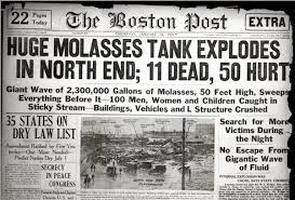


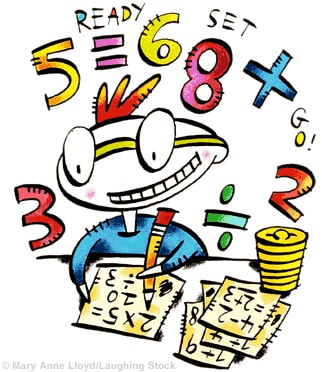

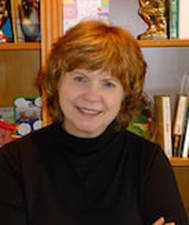

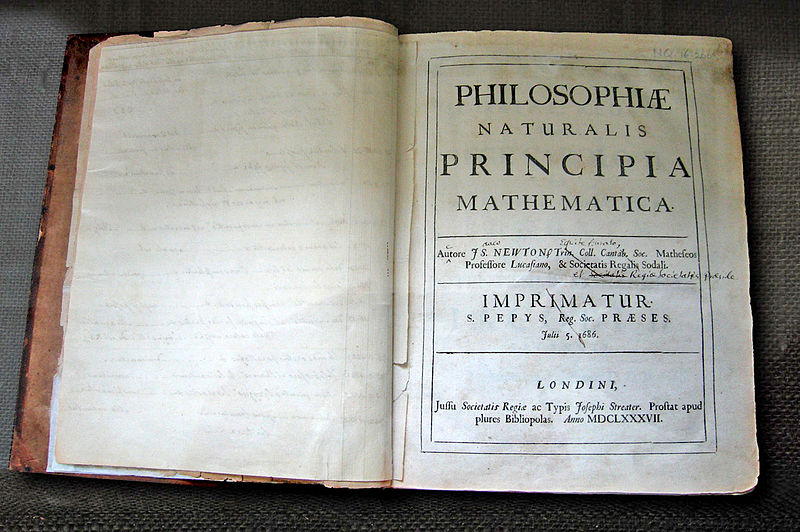
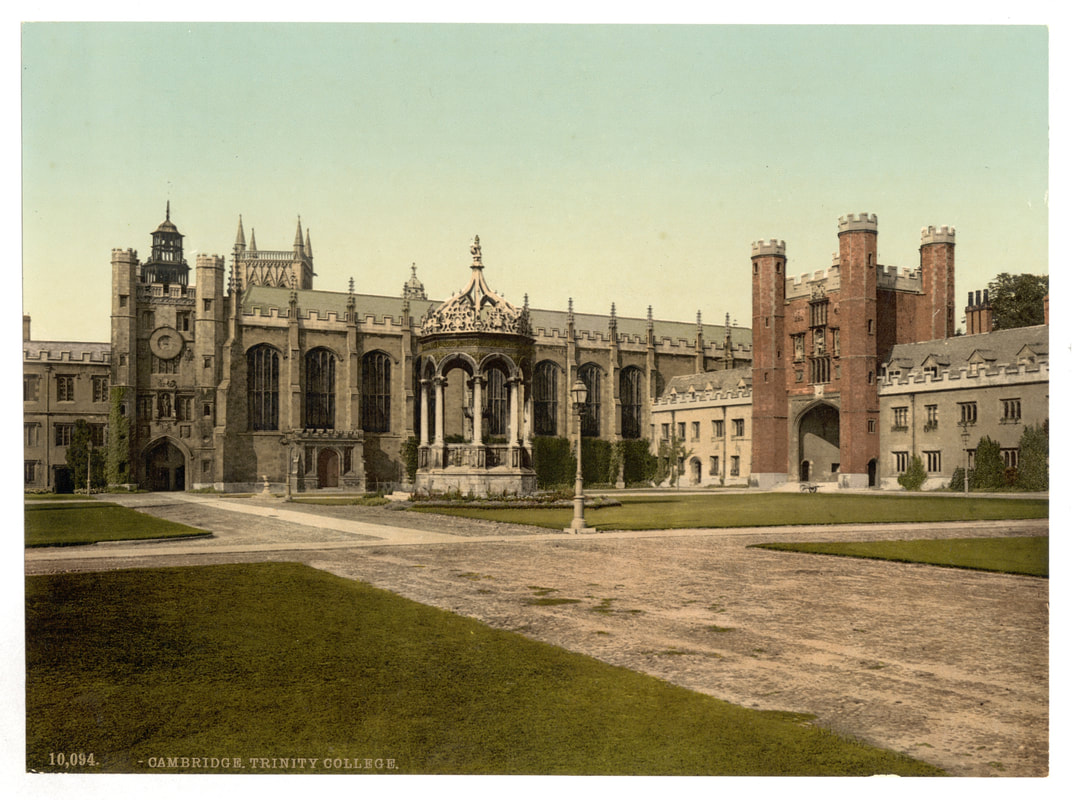
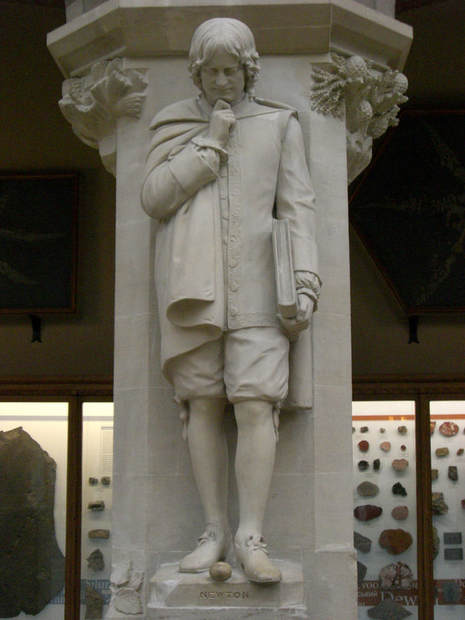

 RSS Feed
RSS Feed
